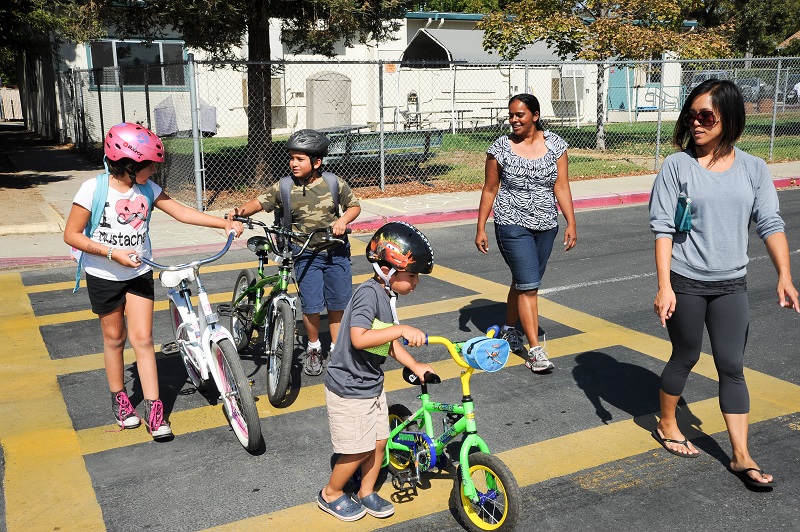Cherokee Nation Public Health works with 14 counties in tribal jurisdictions in northeastern Oklahoma. A community transformation grant from the CDC allowed their work to expand into Safe Routes to School roughly five years ago, laid out specifically as an objective in their community work plan. They work with local community coalitions to align their work plans, keeping Safe Routes to School part of the conversation at all levels where they are involved. They have also been able to introduce SRTS into rural areas that have infrastructure challenges due to access issues.
Resource Library
Key takeaway:
- Active commuters have the highest level of travel satisfaction.
Key takeaway:
- By 2020, California aims to double walking and triple cycling from a 2010 baseline.
Key takeaway:
- Overweight and obesity are leading cancer risk factors. There are at least 13 different types of cancer associated with overweight and obesity, which comprise forty percent of all diagnosed cancers.
Key takeaway:
- More road deaths occur on warmer or wetter days. There was an unusual and sudden spike in road deaths in the US in 2015, which reversed a downward trend in road deaths over the past 35 years. Author argues that the 2015 road death spike is associated with the unusual temperature rise from 2014 to 2015.
Key takeaway:
- This newly developed resource identifies the most dangerous intersections in New York City and provides data about pedestrian collisions in the city on a heat map.
Key takeaway:
- Barriers to children’s pedestrian safety include longer block lengths, missing sidewalks, crosswalk density, and commercial land uses around schools.
With the remaining days of the year quickly winding down, Congress has a very short window to address a legislative pileup.
Congress has not yet reached agreement on spending levels for government agencies, with the current extension ending on December 8. There is likely to be an extension for another few weeks or even until early January. Negotiations have been challenging, as they include spending levels as well as a resolution to the end of the DACA immigration policy for young people—so a government shutdown is not out of the picture.
When I was growing up, I thought we’d all be zooming around the skies, by now, in our automated bubble vehicles - like the Jetsons. Turns out, I wasn’t too far off.
Though not for flying around in the blue yonder, automated vehicles (AV) are in our very, very near future. Already, there are actual demonstration AVs on public roads - can you imagine a car or bus without a steering wheel? Vehicles like these are being tested now.
As the weather began to warm in spring 2017, something else was heating up too – the Safe Routes Partnership’s new Safe Routes to School Launch Program! With five cities participating in the 2017 pilot year, the intensive program helped communities move to a new level of safety and support for students walking and biking to school. The Safe Routes to School Launch Program is a joint project of the Safe Routes Partnership (Safe Routes Partnership) and UC Berkeley Safe Transportation Research and Education Center (SafeTREC), designe
This is the first study that combines GPS, accelerometer, and travel diary data to measure pedestrian exposure to collision risk.
In too many neighborhoods, local stores carry no fresh produce or other healthy options, but getting to healthy foods is dangerous and inconvenient due to unsafe walking conditions and lack of access to public transit or private vehicles.
A growing body of research shows that there are three primary domains that influence young people’s active transportation to school: the physical environment, the sociocultural environment, and the safety environment.
San Francisco is the first city in the country to combine mapped hospital data with police injury data to analyze spatial patterns of severe and fatal injuries to target interventions in support of Vision Zero goals.
Globally, people with lower incomes and people of color are disproportionately at risk of being injured or killed in motor vehicle crashes, especially as pedestrians.
Equity in active transportation is under-researched within academic scholarship and inconsistently applied in practice, but that is changing as it gains more salience in research and practice.
 We have been beating the drum for several months now to encourage states to fully spend their Transportation Alternatives Program (TAP) funds before the critical deadline of September 30, 2017, when any unused FY2014 funds would expire after four years.
We have been beating the drum for several months now to encourage states to fully spend their Transportation Alternatives Program (TAP) funds before the critical deadline of September 30, 2017, when any unused FY2014 funds would expire after four years.
Vision Zero is a growing movement to eliminate all traffic deaths and serious injuries. Safe Routes to School is a comprehensive approach to making it safe for kids to walk and bike to school.
Blue and white lights flash behind you. The weee-ooo, weee-ooo of sirens pierce your ears. Your heart races. You slowly pull your car to the shoulder of the road. Sure enough, you receive a ticket for your infraction.
Paying the ticket would take half of your grocery money for the month. Sadly, you cannot pay the exorbitant cost. Then a late fee gets added, then another, and another, until your license gets suspended or even worse, a warrant is issued for unpaid traffic tickets.

